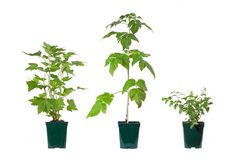 In the last 10 years, a product form of the berry plant has become established that looks very similar with very many suppliers: A plant in a 2l container, usually accurately tied up, with a large, more or less eye-catching label.
In the last 10 years, a product form of the berry plant has become established that looks very similar with very many suppliers: A plant in a 2l container, usually accurately tied up, with a large, more or less eye-catching label.
It is not really the individual berry plant, the individual pot that is offered, but a fixed mixed assortment on a CC Trolley. What you then find on this CC is quite often a surprise bag, certainly many raspberries, fewer blackberries, surprisingly many blueberries and then all the other bush berries. More and more often you also find small kiwi plants, figs, mulberries and other exotics on this mix CC. How should we assess this development?
The standard berry plant - an attempt at an objective assessment
Of course, the standard berry plant that has emerged in this way also has its good side: some distribution channels that previously did not buy berries, or only bought a few, have now closed this gap with the help of Mix CC. Their buyers no longer have to deal with an unmanageable amount of products, but actually only with one product, the unit berry plant, the unit berry CC. This has undoubtedly led to an increase in volume. But of course this standardisation and egalitarianism also makes it almost impossible to work out individuality and specific values and to communicate them to the reseller and at best to the end customer.
The uniform assortment from the point of view of DIY stores and food retailers
From the distributors' point of view, the uniform product (small berry plants on CC) also has the advantage that everything is comparable. Product and producer are largely interchangeable. This is also the easiest way to defend low purchase prices. Whether this or that CC ends up at the point of sale is hardly decisive.
The uniform assortment from the plant producer's point of view
From the plant producer's point of view, the uniform assortment certainly has its advantages. Uniformity at the point of sale corresponds to equal treatment in production. Varieties of different fruit types are selected, which can ultimately be cultivated and processed in the same way. There is no horticultural reason to cut back a raspberry 2 or 3 times more than the available space on the CC. But this uniformity also facilitates production and its scaling. On the sales front, however, the plant producer's leeway is very limited. He no longer sells sea buckthorn, raspberries, figs and blueberries, nor mulberries and currants, but simply berry plants on CC. Many products become one product. The sales risk becomes greater, if not all CC are called up, there is quickly a lot left over. It is hardly possible to value the individual plants and specialities. The customer's willingness to pay for a nice big survivable fig plant or for a currant bush that will be full of fruit next year is not exploited What difference does it make if I sell a new raspberry variety like the Schlaraffia® family or if I just add Willamette and Meeker to the CC? Oh yes, one is autumn-bearing raspberries, the other is summer raspberries - but even that is not always of interest in the value chain...
The uniform assortment from the point of view of the end customer
From the point of view of the hobby gardener, the end customer, there are certainly some positive things to report, for example, thanks to the berry CC, quite broad berry assortments are sold at more points of sale. He cannot complain about the price of the plants either, the mechanisms described keep the price low, no matter whether it is a 50-year-old raspberry variety or a special fig. But in many respects the CC uniform offer is not really geared to the consumer.
Or does it make sense to buy a 20cm high mini kiwi that will freeze back at the first late spring frost. Or does the fig have a chance of survival with a shoot maybe just 1cm thick and cut back to 25cm. And how long will the customer have to wait before he will really have a significant harvest from the currants, gooseberries and blueberries in the 1l or 2l pot?
Conclusion
The uniform assortment of berry plants on the CC has led to a significant increase in volume and better availability of berry plants on the market. Similarly, there are also efficiency benefits from uniform production. From the point of view of the plant producer and also the end customer, however, there are also considerable disadvantages, especially if one restricts oneself almost exclusively to this uniform product. It is therefore very important, especially for plant producers, to differentiate the range of varieties, sizes and uses, thus also adding value to specialities and new varieties and at the same time reducing their own interchangeability.
Possible measures
- offer different assortments in different sizes
- fewer varieties and species on one CC (if possible)
- separate offers of plants that are usually planted in larger numbers (strawberries, raspberries, at most blackberries on the one hand, and on the other hand plants that are often planted individually such as currants, gooseberries, blueberries)
- valuable specialities such as figs and mulberries, but also kiwis, should, if possible, not be included in the standard assortments...
Of course, each producer has to find his own way here. When talking to retailers, it is important to show that you always focus on the needs of the end customer. But the motto applies to all of us (also to the young plant producer): Differentiate yourselves!
